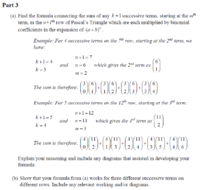MrAnderson
New member
- Joined
- Sep 1, 2019
- Messages
- 2
Hi there,
Just wondering if someone can help me in finding the formula "connecting the sum of any k + 1 successive terms, starting at the m th term, in the n+1 th row of Pascal's Triangle which are each multiplied by the binomial coeffcients in the expansion of (a+b)^k ((a+b) the the power of k).
I have attached the investigation is any clarification is needed. You can find my specific question in Part 3 (a).
Thanks,
AC
Just wondering if someone can help me in finding the formula "connecting the sum of any k + 1 successive terms, starting at the m th term, in the n+1 th row of Pascal's Triangle which are each multiplied by the binomial coeffcients in the expansion of (a+b)^k ((a+b) the the power of k).
I have attached the investigation is any clarification is needed. You can find my specific question in Part 3 (a).
Thanks,
AC

